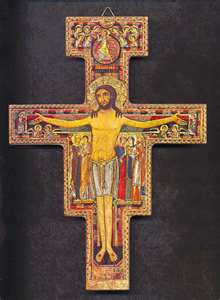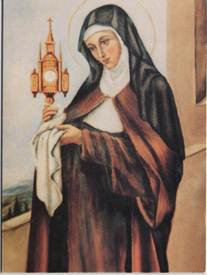ST. CLARE'S FEAST DAY: AUGUST 11
 FRANCIS
met the Lord when he embraced the leper and when he begged for stones
and food; and he would never be detoured from that way, because he had
found the Lord there. Saint Clare finds God in the poverty of
contemplation, and she in turn never swerves from her way to
the end of her life. For Clare poverty and contemplation are so
intimately intertwined that contemplation presupposes poverty, because the Lord promises and gives the Kingdom of Heaven only to the poor.
FRANCIS
met the Lord when he embraced the leper and when he begged for stones
and food; and he would never be detoured from that way, because he had
found the Lord there. Saint Clare finds God in the poverty of
contemplation, and she in turn never swerves from her way to
the end of her life. For Clare poverty and contemplation are so
intimately intertwined that contemplation presupposes poverty, because the Lord promises and gives the Kingdom of Heaven only to the poor. As she writes in one of her letters, What a praiseworthy exchange: to leave temporal things for those that are eternal, to choose heavenly things for earthly goods, to receive a hundredfold instead of one, and to possess a life, blessed and eternal.
As with Francis, Clare’s poverty is not for its own sake but because it makes present the Kingdom and because of an ardent desire for the Poor Crucified.
Since the great and good Lord, on entering the Virgin’s womb, chose to look despised, needy, and poor in this world, so that people in dire poverty and deprivation and in absolute need of heavenly nourishment might become rich in Him by possessing the Kingdom of Heaven, then you who have chosen poverty should rejoice and be glad!
Always it is the Poor Christ whom Clare is determined to gaze upon, consider and contemplate, because He is the image of God, the Mirror we are to contemplate.
 This
image of the mirror is central to Saint Clare’s spirituality. As
Francis was the mirror of Christ and Christ of the Father, so the life
of the contemplative is to look into the mirror that is Christ and see
there oneself, thereby learning who you are. By looking into the mirror
who is Christ and recognizing yourself, you become a mirror of Him whom
you contemplate, and you in turn mirror, through Christ to the Father,
all the creation. You see yourself both in a mirror and as a mirror.
This
image of the mirror is central to Saint Clare’s spirituality. As
Francis was the mirror of Christ and Christ of the Father, so the life
of the contemplative is to look into the mirror that is Christ and see
there oneself, thereby learning who you are. By looking into the mirror
who is Christ and recognizing yourself, you become a mirror of Him whom
you contemplate, and you in turn mirror, through Christ to the Father,
all the creation. You see yourself both in a mirror and as a mirror.Saint Clare writes to her sisters: For the Lord Himself has not only placed us as example and mirror for others, but also for our own sisters whom the Lord has called to our way of life, so that they in their turn will be mirror and example to those living in the world.
This complex imagery shows Saint Clare’s profound acquaintance with Sacred Scripture, with the literature of the Fathers of the Church, and with the lyrics of the troubadours, all of which are replete with mirror imagery.
There is, for example, a famous twelfth-century version of Ovid’s tale of Narcissus in which the troubadour has his Narcissus recognize that he is different from his image in the water, thereby discovering his own separate identity. For a contemplative like Saint Clare, however, the birth of self-consciousness through recognition is not enough. She finds her true identity by looking upon Christ and seeing there herself as an image of the Divine; and the more perfectly she mirrors the image of Christ, the more real she becomes. She says in a letter to Blessed Agnes of Prague: Because the vision of Christ is the splendor of eternal glory, the radiance of eternal light and the mirror without stain, look upon that mirror each day, O queen and spouse of Jesus Christ, and continually study your countenance within it, so that you may clothe yourself inside and out with beautiful robes and cover yourself with the flowers and garments of all the virtues, as becomes the daughter and most chaste bride of the Most High King. Indeed blessed poverty, holy humility, and ineffable charity are reflected in that mirror, and, with the grace of God, you can contemplate them throughout the entire mirror.
 She then expands her imagery to include the whole
mirror. Look at the edges of this mirror, and see the poverty of Him
who was placed in a manger and wrapped in swaddling clothes. Then
looking at the surface of the mirror, dwell on the holy humility, the
blessed poverty, the untold labors and burdens which He endured for the
redemption of all humankind. Then, in the deep center of the mirror,
contemplate the ineffable charity which led Him to suffer on the wood of
the Cross, dying on it the most shameful kind of death. Therefore, that
mirror hanging on the wood of the Cross urged those who passed by to
consider, saying: “All you who pass by the way, look and see if there is
any suffering like My suffering!”
She then expands her imagery to include the whole
mirror. Look at the edges of this mirror, and see the poverty of Him
who was placed in a manger and wrapped in swaddling clothes. Then
looking at the surface of the mirror, dwell on the holy humility, the
blessed poverty, the untold labors and burdens which He endured for the
redemption of all humankind. Then, in the deep center of the mirror,
contemplate the ineffable charity which led Him to suffer on the wood of
the Cross, dying on it the most shameful kind of death. Therefore, that
mirror hanging on the wood of the Cross urged those who passed by to
consider, saying: “All you who pass by the way, look and see if there is
any suffering like My suffering!” The most striking reality that this imagery confronts us with is the poverty of God. The Poor Christ is the image of the Godhead! God is poor, God is self-emptying; and in our poverty, our resemblance to the poor, crucified Christ, we become mirrors of God Himself. Poverty, then, is not an end in itself, but a way of becoming transformed into an image of the Trinity by contemplating the Mirror of the Trinity, Jesus Christ Himself. As a mirror is material, yet holds an immaterial image, so the Poor Christ is human and visible, yet is an image of the invisible God, who is poor in Triune self-emptying that is simultaneously a filling up.
It is no wonder then that Saint Clare holds so tenaciously to contemplation and poverty as a way of life: The two are one: the contemplation of poverty becoming the poverty of contemplation.
Source: Murray Bodo OFM, THE WAY OF ST. FRANCIS – The Challenge of Franciscan Spirituality for Everyone, Cincinnati, OH: St. Anthony Messenger Press, 1995, pages 29-31.
No comments:
Post a Comment